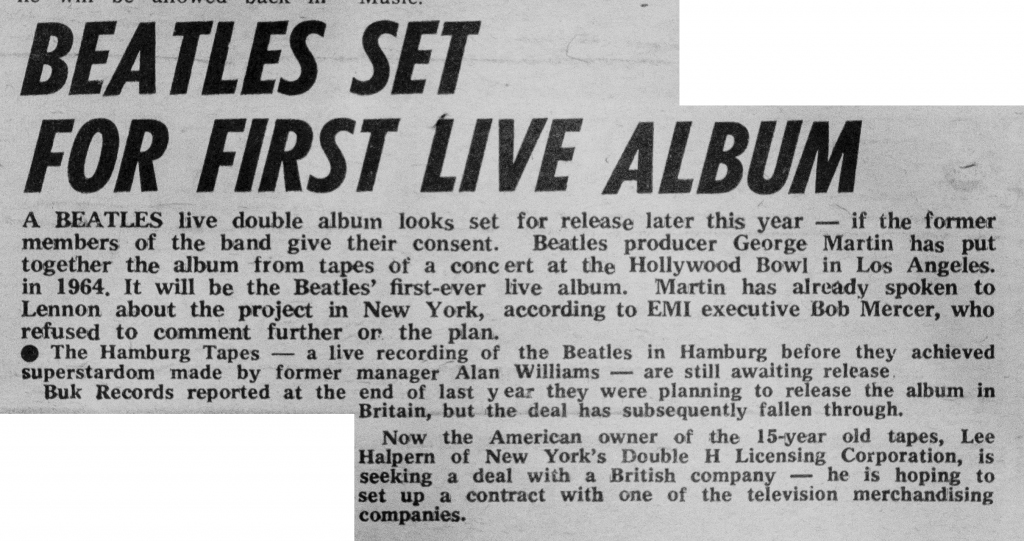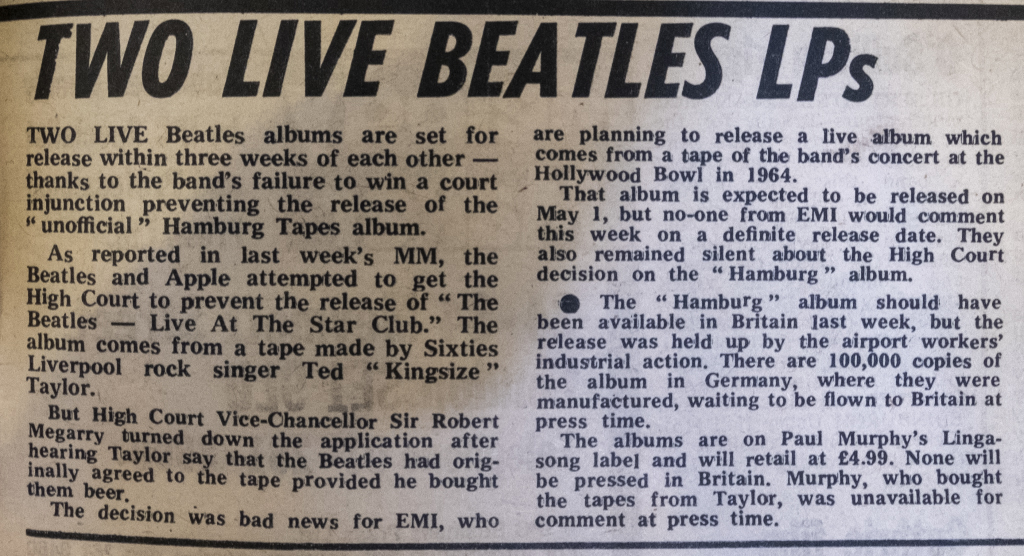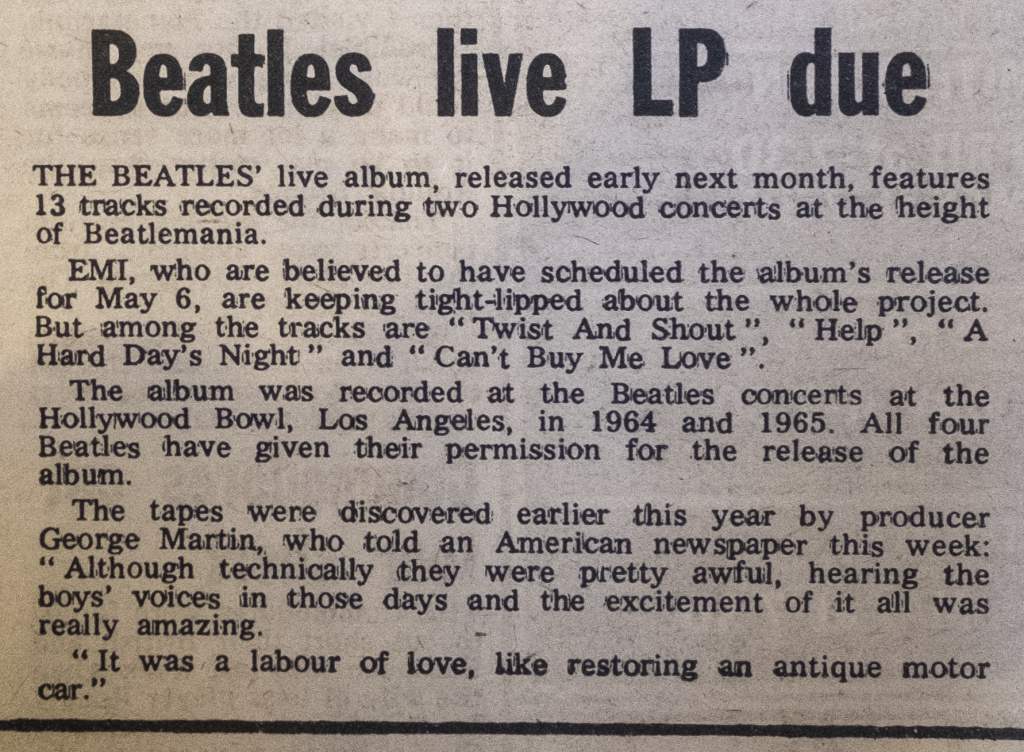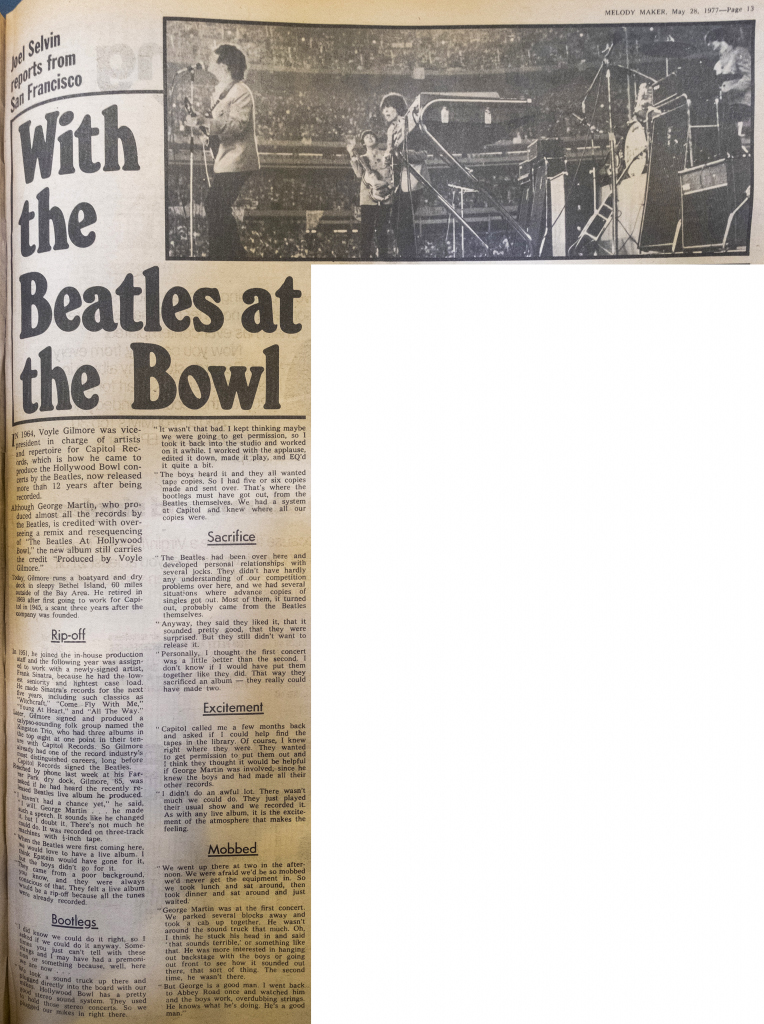US Release date : Wednesday, May 4, 1977
The Beatles At The Hollywood Bowl
By The Beatles • Official live • Part of the collection “The Beatles • Post break-up albums”
Last updated on December 26, 2022
US Release date : Wednesday, May 4, 1977
By The Beatles • Official live • Part of the collection “The Beatles • Post break-up albums”
Last updated on December 26, 2022
Previous live album Dec 10, 1976 • "Wings Over America" by Wings released in the US
Article May 1977 • Press coverage for "Thrillington"
Session May 1 to May 31, 1977 • "London Town" sessions #2
Live album May 04, 1977 • "The Beatles At The Hollywood Bowl" by The Beatles released in the US
Album May 06, 1977 • "Holly Days" by Denny Laine released in the UK
Live album May 06, 1977 • "The Beatles At The Hollywood Bowl" by The Beatles released in the UK
This album was recorded during the following studio sessions:
Mixing "The Beatles At The Hollywood Bowl"
January 1977
Written by Phil Medley, Bert Russell
1:32 • Live • L1
George Martin : Producer Geoff Emerick : Mastering, Remix engineer Voyle Gilmore : Producer Wally Traugott : Mastering
Concert From the concert in Los Angeles, USA on Aug 30, 1965
Session Mixing: January 1977 • Studio AIR Studios, London, UK
2:53 • Live • L1
George Martin : Producer Geoff Emerick : Mastering, Remix engineer Voyle Gilmore : Producer Wally Traugott : Mastering
Concert From the concert in Los Angeles, USA on Aug 30, 1965
Session Mixing: January 1977 • Studio AIR Studios, London, UK
Written by Larry Williams
3:37 • Live • L1 • Composite using parts from August 29th and August 30th
George Martin : Producer Geoff Emerick : Mastering, Remix engineer Voyle Gilmore : Producer Wally Traugott : Mastering
Concert From the concert in Los Angeles, USA on Aug 29, 1965
Session Mixing: January 1977 • Studio AIR Studios, London, UK
2:51 • Live • L1
George Martin : Producer Geoff Emerick : Mastering, Remix engineer Voyle Gilmore : Producer Wally Traugott : Mastering
Concert From the concert in Los Angeles, USA on Aug 29, 1965
Session Mixing: January 1977 • Studio AIR Studios, London, UK
2:16 • Live • L1
George Martin : Producer Geoff Emerick : Mastering, Remix engineer Voyle Gilmore : Producer Wally Traugott : Mastering
Concert From the concert in Los Angeles, USA on Aug 30, 1965
Session Mixing: January 1977 • Studio AIR Studios, London, UK
2:20 • Live • L1
George Martin : Producer Geoff Emerick : Mastering, Remix engineer Voyle Gilmore : Producer Wally Traugott : Mastering
Concert From the concert in Los Angeles, USA on Aug 23, 1964
Session Mixing: January 1977 • Studio AIR Studios, London, UK
Written by Chuck Berry
2:28 • Live • L1
George Martin : Producer Geoff Emerick : Mastering, Remix engineer Voyle Gilmore : Producer Wally Traugott : Mastering
Concert From the concert in Los Angeles, USA on Aug 23, 1964
Session Mixing: January 1977 • Studio AIR Studios, London, UK
Written by Luther Dixon, Wes Farrell
2:12 • Live • L1
George Martin : Producer Geoff Emerick : Mastering, Remix engineer Voyle Gilmore : Producer Wally Traugott : Mastering
Concert From the concert in Los Angeles, USA on Aug 23, 1964
Session Mixing: January 1977 • Studio AIR Studios, London, UK
3:15 • Live • L1 • Live 30 August 1965 (poss. 23 August 1964)
George Martin : Producer Geoff Emerick : Mastering, Remix engineer Voyle Gilmore : Producer Wally Traugott : Mastering
Concert From the concert in Los Angeles, USA on Aug 30, 1965
Session Mixing: January 1977 • Studio AIR Studios, London, UK
2:46 • Live • L1
George Martin : Producer Geoff Emerick : Mastering, Remix engineer Voyle Gilmore : Producer Wally Traugott : Mastering
Concert From the concert in Los Angeles, USA on Aug 29, 1965
Session Mixing: January 1977 • Studio AIR Studios, London, UK
2:14 • Live • L2
George Martin : Producer Geoff Emerick : Mastering, Remix engineer Voyle Gilmore : Producer Wally Traugott : Mastering
Concert From the concert in Los Angeles, USA on Aug 23, 1964
Session Mixing: January 1977 • Studio AIR Studios, London, UK
2:31 • Live • L1
George Martin : Producer Geoff Emerick : Mastering, Remix engineer Voyle Gilmore : Producer Wally Traugott : Mastering
Concert From the concert in Los Angeles, USA on Aug 23, 1964
Session Mixing: January 1977 • Studio AIR Studios, London, UK
Written by Richard Penniman / Little Richard, Enotris Johnson, Robert Blackwell
2:53 • Live • L1
George Martin : Producer Geoff Emerick : Mastering, Remix engineer Voyle Gilmore : Producer Wally Traugott : Mastering
Concert From the concert in Los Angeles, USA on Aug 23, 1964
Session Mixing: January 1977 • Studio AIR Studios, London, UK
From Wikipedia:
The Beatles at the Hollywood Bowl is a live album by the Beatles released on 5 May 1977 featuring songs compiled from two performances at the Hollywood Bowl in August 1964 and August 1965. The album was released by Capitol Records in the United States and Canada and by Parlophone in the United Kingdom. A remixed, remastered and expanded version of the album, retitled Live at the Hollywood Bowl, was released on 9 September 2016 to coincide with the release of the documentary film The Beatles: Eight Days a Week directed by Ron Howard.
Background
Initially, Capitol Records considered recording the Beatles’ February 1964 concert at Carnegie Hall in New York, but it could not obtain the necessary approval from the American Federation of Musicians to record the performance. Six months later, KRLA DJ Bob Eubanks booked the band’s performance of 23 August at the Hollywood Bowl in Los Angeles, where Capitol recorded their performance with the aim of releasing a live album in America. The sound quality of the tapes proved to be inadequate for commercial release, however, although Capitol utilised a 48-second excerpt of “Twist and Shout” from the concert on the 1964 documentary album The Beatles’ Story.
High-quality black-and-white film of the 1964 show was also made and preserved. Excerpts of “All My Loving” and “She Loves You” from the 23 August 1964 performance appeared in the 1995 The Beatles Anthology documentary series.
When the Beatles returned to the Hollywood Bowl a year later during their 1965 American tour, Capitol recorded two performances by the group at the same venue. The sound quality of the 1965 recordings was equally disappointing, however.
The Beatles were among the few major recording artists of the 1960s not to have issued a live album. Consequently, among Beatles fans, pent-up demand for a concert album continued to build. In fact, John Lennon set off a minor frenzy when, in a 1971 Rolling Stone interview, he incorrectly identified an obscure Italian compilation album, The Beatles in Italy, as a live recording (“There’s one in Italy apparently, that somebody recorded there”). Despite the obvious demand for a live album, the tapes from the three Hollywood Bowl performances continued to sit untouched in a Capitol vault. In 1971, following his salvaging of the Get Back tapes, which was released as the group’s Let It Be album, the Hollywood Bowl tapes were given to American record producer Phil Spector to see if he could fashion an album out of the material. Either Spector did not complete the job or his production was unsatisfactory, and the tapes continued to sit unreleased for another six years.
A complete tape of the August 1964 performance found its way out of the Capitol vault in the early 1970s and formed the basis for a popular bootleg LP Back in 64 at the Hollywood Bowl. The audio, while below professional release standards, was more than adequate for desperate hardcore fans and served for years as the standard recording of the summer 1964 tour.
Finally, with a rival record label’s impending release of the Live! at the Star-Club in Hamburg, Germany; 1962 album consisting of a 15-year-old, poor-quality mono concert recording of the group performing in the Star-Club in Hamburg, Capitol Records’ president, Bhaskar Menon, decided to revisit the Hollywood Bowl recordings. Beatles’ producer George Martin was handed the tapes and asked to compile a listenable “official” live album.
When Martin was asked by Menon to hear the tapes, he was impressed with the performances but disappointed in the sound quality. In working on the three-track Hollywood Bowl concert tapes, Martin discovered quite a challenge. The first difficulty was finding a working three-track machine with which to play back the master tapes. Once he found one, he discovered that the machine overheated when it was running, melting the magnetic tape. Martin and recording engineer Geoff Emerick came up with the solution of blowing air from a vacuum cleaner to keep the tape deck cool whilst the recordings were transferred to 16-track tape for filtering, equalisation, editing, and mixing. Martin found the 29 August 1965 recording virtually useless, and, except for a few dubs taken from the performance of 29 August to augment other performances, the album compiled by Martin consisted entirely of songs recorded on 23 August 1964 and 30 August 1965.[citation needed]
A number of songs performed at the two concerts were not included on the album. Songs from the 1964 show not included on the album are: “Twist and Shout“, “You Can’t Do That“, “Can’t Buy Me Love“, “If I Fell“, “I Want to Hold Your Hand” and “A Hard Day’s Night“. Songs from the 1965 show not included on the album are: “I Feel Fine“, “Everybody’s Trying to Be My Baby“, “Baby’s in Black“, “I Wanna Be Your Man” and “I’m Down“. “Baby’s in Black”, from the 1965 Hollywood Bowl concert, however, was issued as the B-side of the 1996 “Real Love” single, and “I Want to Hold Your Hand” from the 1964 concert was mixed into the studio version of the song for the 2006 Love album. “Baby’s in Black” was often included on bootlegs of the album and remained officially unavailable on an album until the release of Live at the Hollywood Bowl in 2016.
Although the original album sleeve says that the recordings were all made on 23 August 1964 or 30 August 1965,[citation needed] “Ticket to Ride” and “Help” were recorded on 29 August 1965, and “Dizzy, Miss Lizzy” is a composite using parts from both nights in 1965.
Release
The album was originally released as a vinyl LP. Even though the recordings on The Beatles at the Hollywood Bowl were between 12 and 13 years old, the album reached number one on the New Musical Express chart in the UK and number two on the Billboard chart in the US. In New Zealand, it was to be pressed and released locally with the catalogue number PCS 6130 (the 6000 series was designated for EMI (NZ) only releases), but this did not occur. Instead, New Zealand pressed the record and used the Australian catalogue number PCSO 7577.[citation needed]
The album was officially released in several countries on cassette but was not officially released on compact disc until 9 September 2016, when it was re-released worldwide as Live at the Hollywood Bowl. Shortly before the re-release date, a number of tracks were available for purchase and streaming early, and the album was available for pre-order on the iTunes Store. The re-released album was simultaneously released as a digital download and made available on streaming services. It was also released on vinyl on 18 November 2016.
A music video for the performance of “Boys” was released to promote the remixed album.
Before the official digital release of the album, bootleggers circulated transfers of the LP as well as complete recordings of the three concerts on CD and the Internet.
Critical reception
The Beatles at the Hollywood Bowl was voted the 26th best record of 1977 in the Pazz & Jop, an annual poll of American critics published by The Village Voice. Robert Christgau, the poll’s supervisor, ranked it 12th on his own year-end list, and in a review for the newspaper, he wrote:
A tribute not only to the Beatles (which figured) but to George Martin and Capitol (which didn’t necessarily figure at all). The sound rings clearly and powerfully through the shrieking: the segues are brisk and the punch-ins imperceptible; and the songs capture our heroes at their highest. Furthermore, though the musicianship is raw, the arrangements are tighter (faster, actually) than on record.
In The Rolling Stone Album Guide (2004), Rob Sheffield called the record “a loving tribute to the screaming girl fans who drown out the band in these 1964–65 shows; those girls were heroes on the rock & roll frontier, and they deserve to be the lead instrument on a Beatles album of their own.” AllMusic critic Richard S. Ginell was impressed the Beatles’ performances under the chaotic circumstances, although he lamented the sound quality and separation from the crowd noise, citing it as a possible reason for the record remaining out of print.
Live at the Hollywood Bowl
Live at the Hollywood Bowl is a remixed and remastered version of the album, released on 9 September 2016 to coincide with the release of The Beatles: Eight Days a Week. It includes four additional songs not found on the original release. According to the producer, Giles Martin, son of the Beatles’ original producer, George Martin, “Capitol Studios called saying they’d discovered some Hollywood Bowl three track tapes in their archive. We transferred them and noticed an improvement over the tapes we’ve kept in the London archive. Alongside this I’d been working for some time with a team headed by technical engineer James Clarke on demix technology, the ability to remove and separate sounds from a single track.” It was released on 9 September 2016, seven years to the day after the release of the band’s remastered core catalogue and The Beatles: Rock Band.
One of the bonus tracks on the album is “Baby’s in Black” from the “Real Love” single CD, which was previously unavailable on an album or as a digital download. […]
From the liner notes (1977 album):
Over twelve years ago the Beatles appeared for the first time at The Hollywood Bowl in Los Angeles. It was not long after they had made their first impact on the United States, but already two years after I had signed them to a recording contract for EMI. Frankly, I was not in favor of taping their performance. I knew the quality of recording could not equal what we could do in the studio, but we thought we would try anyhow. Technically, the results were disappointing; the conditions for the engineers were arduous in the extreme. The chaos, I might almost say panic, that reigned at these concerts was unbelievable unless you were there. Only three track recording was possible; the Beatles had no “fold back” speakers, so they could not hear what they were singing, and the eternal shriek from 17,000 healthy, young lungs made even a jet plane inaudible.
A year later, in 1965, John, Paul, George and Ringo appeared again at The Hollywood Bowl and again Capitol taped the show for posterity, and there the tapes remained for over a decade. Neither the boys nor I considered they should be used because they consisted of titles that had already been issued as studio recordings, we often spoke of making a live recording, and in fact the ill-fated “Let It Be” album began as an attempt to make a live record of new material.
It was with some misgivings therefore that I agreed to listen to those early tapes at the request of Bhaskar Menon, Capitol’s president. The fact that they were the only live recordings of the Beatles in existence (if you discount inferior bootlegs) did not impress me. What did impress me, however, was the electric atmosphere and raw energy that came over.
And so, together with my recording engineer, Geoff Emerick, I set to work to bring the performance back to life. It was a labor of love, for we did not know if we could make them good enough for the world to hear – let alone John, Paul, George and Ringo.
We transferred the vintage three track tapes to modern multi-track, remixed, filtered, equalized and generally polished the tapes. Then, by careful editing from the two performances, we produced the performance that you hear now, obviously there has been no overdubbing. All the voices and instruments are the original performance (some of the vocal balances, with three singers on one track are evidence enough). But it is a piece of history that will not occur again.
Those of us who were lucky enough to be present at a live Beatle concert – be it in Liverpool, London, New York, Washigton, Los Angeles, Tokyo, Sydney or wherever – will know how amazing, how unique those performances were. It was not just the voice of the Beatles: it was expression of the young people of the world.
And for the others who wondered what on Earth all the fuss was about, this album may give a little clue. It may be a poor substitute for the reality of those times, but it is now all there is.
In the multiplatinum, sophisticated world we live in today, it is difficult to appreciate the excitement of the Beatles breakthrough. My youngest daughter, Lucy, now nine years old, once asked me about them, “You used to record them, didn’t you, Daddy?” she asked, “Were they as great as the Bay City Rollers?” “Probably not,” I replied. Some day she will find out.
Those who clamour for a Beatle reunion cannot see that it can never be the same again. The boys in their own way gave a great deal of their lives to us by being Beatles. And now they have found their own individual selves. Good luck to them. I am very proud to have been part of their story.
Thank you John, Paul, George and Ringo.
George Martin





Notice any inaccuracies on this page? Have additional insights or ideas for new content? Or just want to share your thoughts? We value your feedback! Please use the form below to get in touch with us.